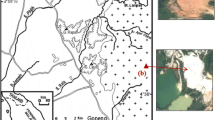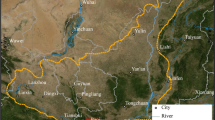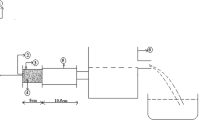Abstract
Core samples to a depth of approximately 50 m and undisturbed soil samples were retrieved from eight locations in the Saga Plain, Japan, to investigate the effects of the depositional environment and post-depositional processes on the engineering properties of Quaternary clays in the Saga Plain. The engineering properties of these soil samples were measured, and the test results showed that the clays in the Saga Plain have a high void ratio, high water content, high compressibility, high sensitivity, and low stiffness. The one-dimensional compression curves plotted above the sedimentation compression line proposed by Burland, and the compression index was high, which indicated that the clays had been cemented to some degree. The clays have high strength sensitivity and high stress sensitivity, indicating that they have strong structures. It was considered that a considerable amount of volcanic ash from the four large volcanic eruptions that occurred during the deposition of these clays settled into the clays, resulting in a certain degree of cementation, which was attributed as the main driver of the strong structure in these clays. Comparisons of the NaCl concentration, pH, and oxidation-reduction potential (ORP) of the clay samples representing the initial depositional environment and the current ground environment showed that salt leaching occurred in the Ariake clay formation, and that the ground environment changed. When the NaCl concentration was less than approximately 2 g/L, the strength sensitivity of the Ariake clay samples with low-activity clay minerals significantly increased due to the decrease in the liquid limit and subsequent significant decrease in the remolded undrained shear strength. Therefore, salt leaching was probably a main cause of the high strength sensitivity of the clays in the Saga Plain. The depositional environment at some locations changed from an alkaline, reducing environment, to an acidic, oxidative environment, with the potential to change into a strongly acidic environment, which could have deteriorated the strength of the cement/lime-treated clays in the Saga Plain.


















Similar content being viewed by others
References
Arulrajah A, Nikraz H, Bo MW (2005) In-situ testing of Singapore marine clay at Changi. Geotech Geol Eng 23(2):111–130
Bjerrum L (1967) Engineering geology of Norwegian normally consolidated marine clays as related to settlements of buildings. Geotechnique 17:81–118
Brand EW, Brenner RP (1981) Soft clay engineering. Elsevier, Amsterdam
Burland JB (1990) On the compressibility and shear strength of natural clays. Géotechnique 40(3):329–378
Cecconi M, Scarapazzi G, Viggiani GMB (2010) On the geology and the geotechnical properties of pyroclastic flow deposits of the Colli Albani. Bull Eng Geol Environ 69:185–206
Chai JC, Hino T, Shen SL, Carter JP (2017) Holocene deposits in Saga Plain: leaching mechanism and soil sensitivity. Geotech Geol Eng 35(5):2107–2122
Chandler RJ (2000) Clay sediments in depositional basin: the geotechnical cycle. Q J Eng Geol Hydrol 33(1):7–39
Chung CK, Finno RJ (1992) Influence of depositional processes on the geotechnical parameters of Chicago glacial clays. Eng Geol 32(4):225–242
Cohen KM, Finney SC, Gibbard PL, Fan JX (2013) The ICS international chronostratigraphic chart. Episodes 36(3):199–204
Du YJ, Hayashi S, Shen SL (2014) Impact of laver treatment practices on the geoenvironmental properties of sediments in the Ariake Sea. Mar Pollut Bull 81(1):41–48
Graham J, Shields DH (1985) Influence of geology and geological processes on the geotechnical properties of a plastic clay. Eng Geol 22:109–126
He P, Ohtsubo M, Abe H, Higasgi T, Kanayama M (2014) Quick clay development and cation composition of pore water in marine sediments from the Ariake Bay Area, Japan. Int J Geosci 5:595–606
Hino T, Jia R, Sueyoshi S, Harianto T (2012) Effect of environment change on the strength of cement/lime treated clays. Front Struct Civ Eng 6(2):153–165
Hino T, Chai JC, Negami T, Bergado DT, Jia R (2014) Assessment of the effects of sea-level change on the geoenvironment: the case of the Ariake Sea coastal lowlands. In: Proceedings of the 9th international symposium on lowland technology, Saga, Japan, pp 21–30
Hong ZS (2006) Correlating compression properties of sensitive clays using void index. Géotechnique 56(8):573–577
Hong ZS, Tsuchida T (1999) On compression characteristics of Ariake clays. Can Geotech J 36:807–814
Horpibulsuk S, Shibuya S, Fuenkajorn K, Katkan W (2007) Assessment of engineering properties of Bangkok clay. Can Geotech J 44(2):173–187
Horpibulsuk S, Yangsukaseam N, Chinkulkijniwat A, Du YJ (2011) Compressibility and permeability of Bangkok clay compared with kaolinite and bentonite. Appl Clay Sci 52:150–159
Howayek AE, Bobet A, Santagata M (2017) Geologic origin effects on mineralogy, index properties and fabric of a fine-grained carbonatic deposit. Eng Geol 216:108–121
Ismael N (1993) Laboratory and field leaching tests on coastal salt-bearing soils. J Geotech Eng 119(3):453–470
Kim YT, Do TH (2011) Experimental evaluation of leaching effects on the compressibility of marine clay and its strain rate dependency. Mar Georesour Geotechnol 29(1):16–29
Liu SY, Shao GH, Du YJ, Cai GJ (2011) Depositional and geotechnical properties of marine clays in Lianyungang, China. Eng Geol 121:66–74
Liu MD, Zhuang ZL, Horpibulsuk S (2013) Estimation of the compression behaviour of reconstituted clays. Eng Geol 167:84–94
Matsui K, Kurobe T, Kato Y (1963) Pedological problems concerning volcanic ash in Japan. Quat Res 3(1-2):40–58 (in Japanese)
Mitchell JK, Soga K (2005) Fundamentals of soil behavior. Wiley, New York
Miura N, Chai JC, Hino T, Shimoyama S (1998) Depositional environment and geotechnical properties of soft deposit in Saga Plain. Indian Geotech J 28(2):121–146
Mizota C, Longstaffe FJ (1996) Detrital origin for smectite in soils and sediments from the coastal plain of Ariake Bay, northern Kyushu, Japan. Geoderma 73(1-2):125–130
Moore JG, Brown JD, Rashid MA (1977) The effect of leaching on engineering behaviour of a marine sediment. Géotechnique 27(4):517–531
Nguyen XP, Cui YJ, Tang AM, Deng YF, Li XL, Wouters L (2013) Effects of pore water chemical composition on the hydro-mechanical behavior of natural stiff clays. Eng Geol 166:52–64
Ohtsubo M, Egashira K, Kashima K (1995) Depositional and post-depositional geochemistry and its correlation with geotechnical properties of the marine clays in Ariake Bay. Geotechnique 45:509–523
Pineda JA, Suwal LP, Kelly RB, Bates L, Sloan SW (2016) Characterisation of Ballina clay. Géotechnique 66(7):556–577
Quigley (1980) Geology, mineralogy and geochemistry of Canadian soft soils: geotechnical perspective. Can Geotech J 17:261–285
Shen SL, Wu HN, Cui YJ, Yin ZY (2014) Long-term settlement behaviour of metro tunnels in the soft deposits of Shanghai. Tunneling Undergr Space Technol 40:309–323
Shimoyama S, Matsuura H, Hino T (2010) Geology of the Saga District, Quadrangle Series, 1:50,000, Fukuoka (14), No. 71, NI-52-11-9, 97 (in Japanese)
Sridharan A, Prakash K (1999) Influence of clay mineralogy and pore-medium chemistry on clay sediment formation. Can Geotech J 36:961–966
Torrance JK, Ohtsubo M (1995) Ariake bay quick clays: a comparison with the general model. Soils Found 35(1):11–19
Warkentin BP, Yong RN (1962) Shear strength of montmorillonite and kaolinite related to interparticle forces. Clay Miner 9:210–218
Woo SM, Moh ZC (1977) Effect of leaching on undrained shear strength behavior of a sedimented clay. Proc. IX Int. Conf. on Soil Mech. and Found. Engrg., Tokyo, Japan, pp 51–464
Wu CJ, Ye GL, Zhang LL, Bishop D, Wang JH (2015) Depositional environment and geotechnical properties of Shanghai clay: a comparison with Ariake and Bangkok clays. Bull Eng Geol Environ 74:717–732
Xu YS, Shen SL, Du YJ (2009) Geological and hydrogeological environment in Shanghai with geohazards to construction and maintenance of infrastructures. Environ Geol 109:241–254
Ye GL, Lin N, Bao XH, Gu LL, Yadav SK (2018) Effect of Quaternary transgression and regression on the engineering properties of Shanghai soft clays. Eng Geol 239:321–329
Zhou GY, Esaki T, Mori J (2003) GIS-based spatial and temporal prediction system development for regional land subsidence hazard mitigation. Environ Geol 44:665–678
Acknowledgments
The site investigation data reported in this paper are from the Ariake Sea Coastal Road Development Office, Saga Prefecture, Japan, whose generosity is greatly appreciated.
Funding
The authors would like to acknowledge the financial support of the National Key Research and Development Program of China (Grant No. 2017YFC0805402), the Major Program of National Natural Science Foundation of China (Grant No. 51890911), and the National Natural Science Foundation of China (Grant No. 51509181).
Author information
Authors and Affiliations
Corresponding author
Rights and permissions
About this article
Cite this article
Jia, R., Zheng, G., Lei, H. et al. The effects of the depositional environment and post-depositional processes on the engineering properties of Quaternary clays in the Saga Plain. Bull Eng Geol Environ 79, 1137–1152 (2020). https://doi.org/10.1007/s10064-019-01653-5
Received:
Accepted:
Published:
Issue Date:
DOI: https://doi.org/10.1007/s10064-019-01653-5




